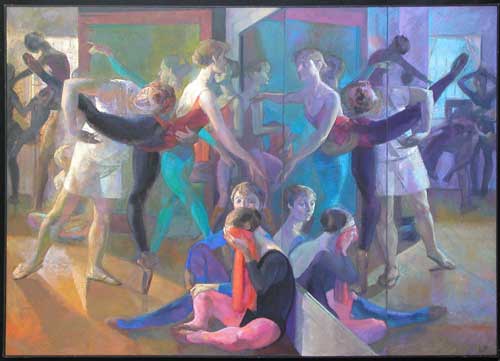Lincoln Perry
Painting a Box of Air
Lincoln Perry finds inspiration in landscapes
By Joshua Bodwell
Lincoln Perry spent a lot of time this past summer driving the back roads of southern Maine, where he has lived part of each year since the mid-1970s. He was looking for landscapes to paint.
“There’s something about a landscape that defies containment,” Perry muses. “After all, you’re just taking one little slice of it.”
The landscapes Perry found were, in many cases, ones he had known for years. But he was looking for something fresh within them. The French author Marcel Proust wrote, “The voyage of discovery is not in seeking new landscapes but in having new eyes,” and that’s just the sort of philosophy that fueled Perry’s landscape expeditions.
“A friend once described landscapes as painting a box of air,” he says. “You could also say a box of light. I was talking on the phone with DeWitt Hardy, talking about landscapes the other day, and he said, ‘All I can think about is shadows!’”
Perry and Hardy have discussed the matter at such length over the years. They’ve even concluded that the landscape painter Jean-Baptiste-Camille Corot must have painted around four in the afternoon.
These sorts of insights aren’t uncommon from Perry. Add to this thoughtfulness a gift for studied observation as well as a mental card-catalog of art history knowledge that is seemingly indefatigable, and you’ll have a pretty good idea of Perry’s mind. Lincoln Perry is a contemporary painter possessed by learning from the past and translating it into something new. He makes no bones about it. This past spring he delivered a lecture in Washington, D.C. with the playful title “Stealing from the Masters.” Perry currently serves as the distinguished visiting artist at the University of Virginia, where he has been creating a massive mural in Cabell Hall—a McKim, Mead, and White building on the UVA campus. It’s titled The Student’s Progress.
In the bright third-floor studio of his Maine house, the ceiling is vaulted. Perry pokes around the room’s edges and brings out dozens of paintings, some in various states of completion. These are the fruits of his summer excursions in search of landscapes.
In several of his new paintings, Perry has created dramatic perspectives of oft-painted sites, such as Wiggly Bridge, a pedestrian suspension bridge on York Harbor. The painting’s rich sky pulses with the dark energy of nature. “[William] Turner is a great example for me,” says Perry. “He wants energy before order.” Perry’s expressive eyebrows rise as he says this; a wide grin spreads across his face.

During trips to South Berwick’s primeval Vaughan Woods, Perry has painted jumbles of standing and fallen trees, using broad swaths of color and a dark palette. Perry seems to prefer edging up against cacophony, rather than perfect compositions that feel too familiar. “I’m looking for these compositions that almost defy order,” he says.
Like Edward Hopper’s finest work, Perry is reaching to create paintings that combine a sense of emotion with formal structure. “I was taught to hate Hopper,” Perry admits with a laugh. “But now…”
In addition to ceaselessly painting and drawing, Perry has been sculpting for over eighteen years. At some point last year, the memory of a Vatican sculpture of Icarus falling, and a long-held interest in sculptures of angles, collided in Perry’s mind with the more recent and more distressing images of people falling from buildings on 9/11. “But the starting impetus is not necessarily the ending impetus,” Perry adds when he discusses the pieces.
Each of Perry’s new sculptures portrays a couple: joined, flailing, plummeting. They are at once both gorgeous and haunting. Their demure size pulls the viewer closer, forcing an intimate interaction with the doomed couples. Shown in suits and dresses, there is an implied backstory of these men and women before their fall. In that poignant then, there is a kind of hope-within-hopelessness, like that found in the first lines of Jack Gilbert’s poem “Failing and Flying”: Everyone forgets that Icarus also flew.
Perry’s new sculptures mark the first time he has worked in wax, and then cast the pieces in bronze. When he found that clay could not fulfill his structural needs, he grew interested in working the wax with hot tools, creating a series of many tiny flat surfaces rather than the single smooth surface he was used to creating in clay. “It’s thrilling,” Perry says of working in the new wax medium. “I think sculpture has changed the way I paint. It’s made me think more volumetric and consider the flat shape on the surface as something capable of moving into space axially.”
In the early, muggy Maine weeks of July, Perry has yet to decide whether the new sculptures will be shown sitting atop pedestals or hanging from wires. He is wary of how viewers will engage with the sculpture. “You don’t want to dictate to people,” he says. “You hope there will be as many readings as possible…”
Joshua Bodwell is the executive director of the Maine Writers & Publishers Alliance, a thirty-five-year-old nonprofit devoted to enriching the cultural life of Maine by supporting writers and the literary arts. Joshua is also a journalist and fiction writer. His work has appeared in Ambit, Down East, Poets & Writers, and The Threepenny Review, and many other journals. His website is www.joshuabodwell.com.
